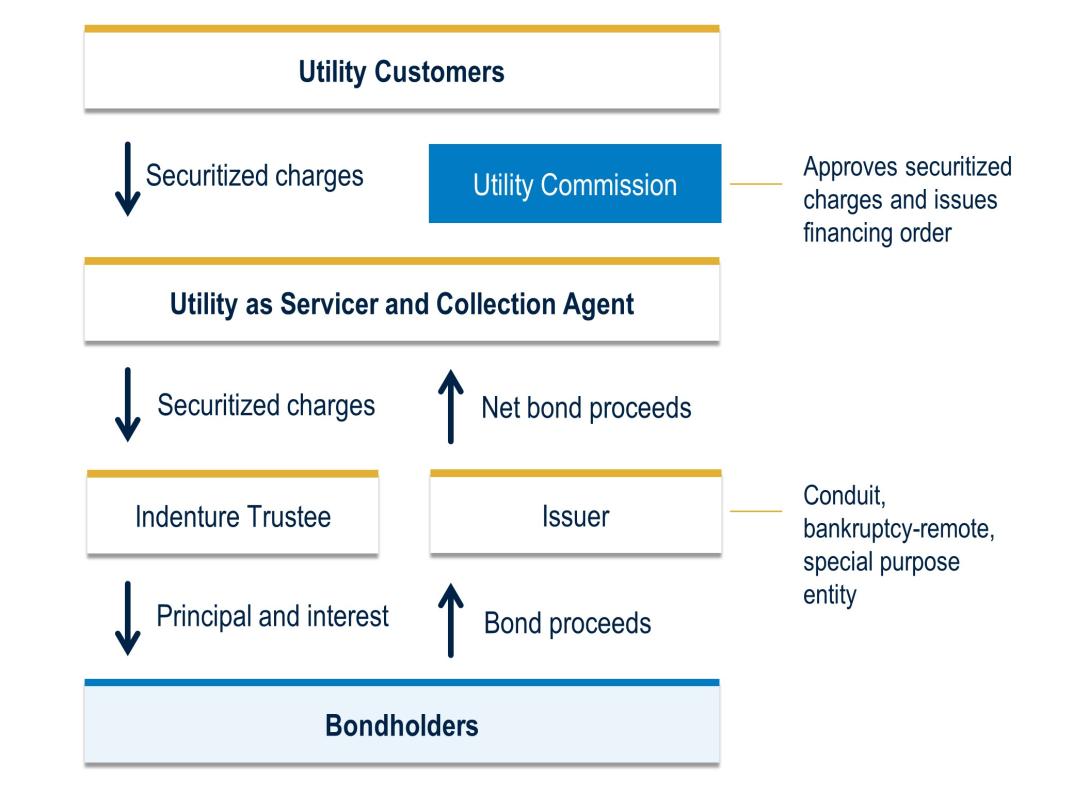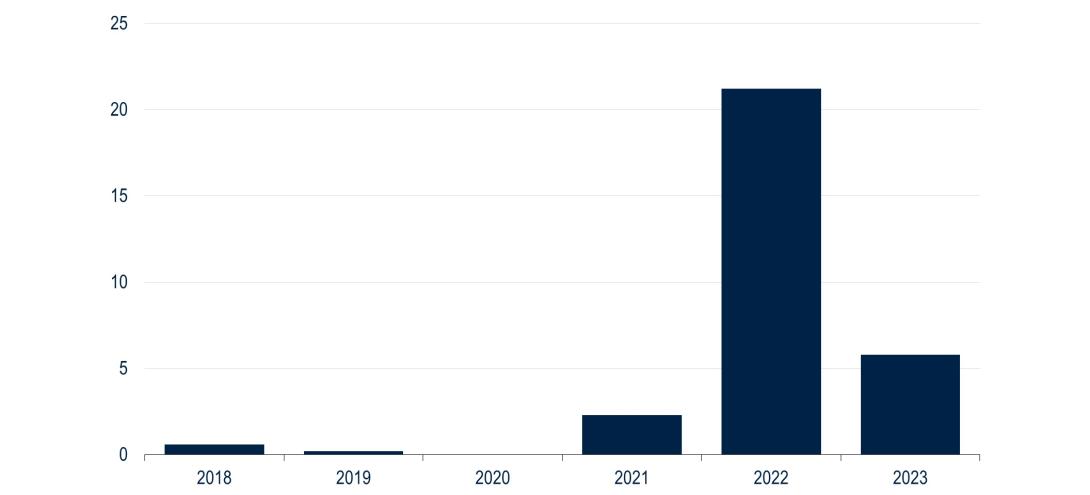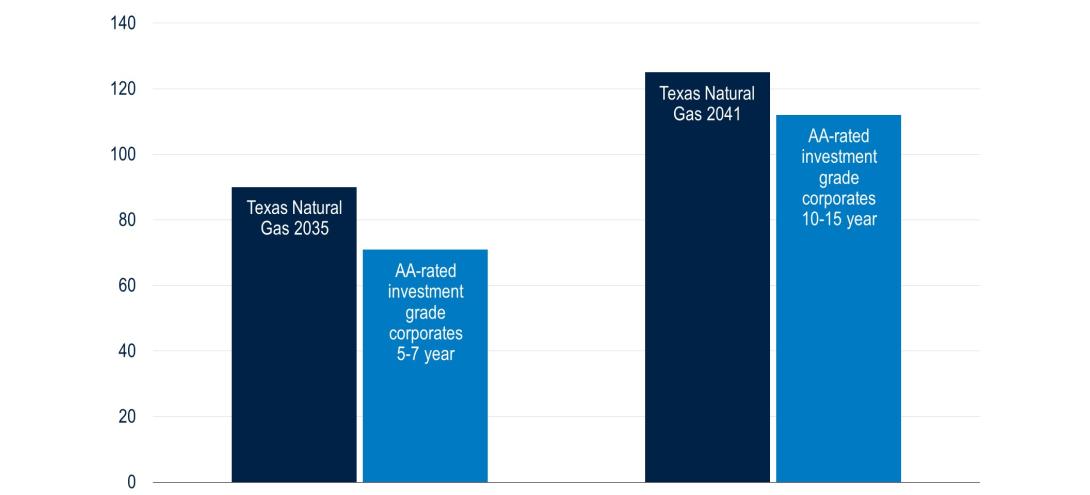Rate Reduction Bonds - Finding Value in an Esoteric Market

Born out of deregulation in the 1990s, rate reduction bonds (RRBs) are increasingly used by utilities to fund costs associated with natural disasters and help fund the transition to clean energy. Securitized by fees charged to a utility’s customers, they typically provide predictable cashflows and are of generally high credit quality. RRBs are issued by a separate special purpose entity (SPE) and are thus bankruptcy remote. These types of bonds also benefit from a “true-up” mechanism that allows the servicer to increase fees at any time. Typically AAA-rated, RRBs are not easily bucketed into one segment of the fixed income world and are often less liquid than more plain vanilla high-grade bonds. Therefore, they often trade at more generous spreads than other similarly-rated securities, providing potential value as a diversifier in a fixed income portfolio.
RRBs are issued by electric and gas utilities to repair or upgrade their systems and are secured by the right to impose and collect charges from all utility customers in each service area. Older vintage RRBs were born out of deregulation when the resulting decrease in revenues caused many electric utility assets to become uneconomic to operate. RRBs were first developed to help recover the costs associated with these “stranded assets.” However, more recent issuance has largely related to natural disasters, helping utilities recover costs associated with wildfires, floods, and hurricanes. We could also see efforts to issue RRBs to help fund the transition to renewables and hardening of assets by the utilities.
Similar to other asset-backed securitizations, a bankruptcy-remote SPE is created by a utility for the sole purpose of issuing RRBs. This isolates bondholders from any risk associated with severe credit deterioration of the utility. The securitization is backed by the right to receive payments from a utility’s customers over the course of several years, with the utility collecting and immediately transferring those payments to the SPE (Figure 1).
Figure 1: The SPE Isolates Bondholders from Event Risk Associated with the Utility

Source: PGIM Fixed Income.
A Highly Predictable Payment Stream
The legal framework for RRBs is based on a securitization law passed by each state legislature and an irrevocable financing order issued by the state’s utility commission. Together, these authorize the issuance of financings and create the collateral, which is the right to collect the securitized charges from ratepayers until the bonds mature. Additionally, a non-impairment pledge is taken by the host states to not take or not permit any action that would impair the value of the collateral in the future.
These bonds also benefit from a statutory and uncapped "true-up" adjustment mechanism that allows the utility to increase the charges, at any time and in an unlimited amount, to pay its debt service. We believe the strength of this mechanism largely mitigates the risk that collections could fall short due to a variety of factors including a significant decline in the ratepayer base, an inability to accurately estimate market demand, or an increase in customers moving to cleaner sources of energy.
The securitized charges may be presented on each customer’s monthly bill as a flat fee, or a fluctuating amount based on kilowatt hour usage and typically make up a small portion (e.g. 6%) of customer bills on average. The relatively small charge, along with a large and diverse customer base, helps ensure a highly predictable payment stream to the bondholders.
Relative Value
The cold snap in Texas that caused millions of customers to lose power in 2021 caused a notable uptick in RRB issuance as a number of electric power cooperatives sought to recover costs incurred in the wake of Winter Storm Uri. Given the success and wider use of these structures, we expect to see more issuance in the coming years.
After totaling $21.2 billion in 2022, issuance thus far in 2023 has totaled $5.8 billion (Figure 2).
Figure 2: RRB Issuance Saw a Spike Following Winter Storm Uri ($ billions)

Source: Finsight. As of June 1, 2023.
By far, the largest deal so far this year was a $3.5 billion, AAA-rated issue for Texas Natural Gas Securitization Corporation aimed at recovering costs incurred by several natural gas utilities in the aftermath of Winter Storm Uri. The costs will now be spread out over many years with the ratepayer charges applied to gas utility bills. The RRBs were issued in two nearly equal tranches, one having a final maturity in 2035 with an average life of 5.96 years and one with a final maturity in 2041 with a 13.42-year average life. Final pricing was 90 bps over five-year Treasuries and 125 bps over 10-year Treasuries, respectively. These spreads were relatively attractive versus other high-quality paper in the asset backed (ABS), corporate, and municipal markets. For context, spreads for AA-rated, 5-7-year and 10-15-year corporates were 19 bps and 13 bps tighter at 71 bps and 112 bps, respectively, at the time (Figure 3).
Figure 3: Texas Natural Gas Securitization RRB Spreads Attractive Versus Corporates (bps)

Source: PGIM Fixed Income, Bloomberg. As of March 10, 2023.
The Liquidity Premium
RRBs are not easily bucketed into one segment of the fixed income world. Depending on the sponsor of the issuance, RRBs can find their way into the ABS, corporate, or municipal markets. Since the utilities and SPEs issuing the bonds can be public or corporate, the classification of security type can also vary. We believe this creates the potential for mispricing and an opportunity to invest in high quality securities at more generous spreads than similar rated securities. In addition, RRBs are less liquid than more plain vanilla bonds due to the esoteric nature and generally small size of the market, which also contributes to their somewhat wider spreads.
Although not without risk, RRBs are high-quality bonds that offer a range of duration profiles and a notable yield advantage over other similarly-rated assets—especially in the new issue market when concessions are often offered in order to place the large-sized deals. For investors willing to sacrifice some amount of liquidity, we believe they offer compelling value as a diversifying fixed income asset class.
Read More From PGIM Fixed Income
Source(s) of data (unless otherwise noted): PGIM Fixed Income, as of 6/13/2023.
For Professional Investors only. Past performance is not a guarantee or a reliable indicator of future results and an investment could lose value. All investments involve risk, including the possible loss of capital.
PGIM Fixed Income operates primarily through PGIM, Inc., a registered investment adviser under the U.S. Investment Advisers Act of 1940, as amended, and a Prudential Financial, Inc. (“PFI”) company. Registration as a registered investment adviser does not imply a certain level or skill or training. PGIM Fixed Income is headquartered in Newark, New Jersey and also includes the following businesses globally: (i) the public fixed income unit within PGIM Limited, located in London; (ii) PGIM Netherlands B.V., located in Amsterdam; (iii) PGIM Japan Co., Ltd. (“PGIM Japan”), located in Tokyo; (iv) the public fixed income unit within PGIM (Hong Kong) Ltd. located in Hong Kong; and (v) the public fixed income unit within PGIM (Singapore) Pte. Ltd., located in Singapore (“PGIM Singapore”). PFI of the United States is not affiliated in any manner with Prudential plc, incorporated in the United Kingdom or with Prudential Assurance Company, a subsidiary of M&G plc, incorporated in the United Kingdom. Prudential, PGIM, their respective logos, and the Rock symbol are service marks of PFI and its related entities, registered in many jurisdictions worldwide.
These materials are for informational or educational purposes only. The information is not intended as investment advice and is not a recommendation about managing or investing assets. In providing these materials, PGIM is not acting as your fiduciary. PGIM Fixed Income as a general matter provides services to qualified institutions, financial intermediaries and institutional investors. Investors seeking information regarding their particular investment needs should contact their own financial professional.
These materials represent the views and opinions of the author(s) regarding the economic conditions, asset classes, securities, issuers or financial instruments referenced herein. Distribution of this information to any person other than the person to whom it was originally delivered and to such person’s advisers is unauthorized, and any reproduction of these materials, in whole or in part, or the divulgence of any of the contents hereof, without prior consent of PGIM Fixed Income is prohibited. Certain information contained herein has been obtained from sources that PGIM Fixed Income believes to be reliable as of the date presented; however, PGIM Fixed Income cannot guarantee the accuracy of such information, assure its completeness, or warrant such information will not be changed. The information contained herein is current as of the date of issuance (or such earlier date as referenced herein) and is subject to change without notice. PGIM Fixed Income has no obligation to update any or all of such information; nor do we make any express or implied warranties or representations as to the completeness or accuracy.
Any forecasts, estimates and certain information contained herein are based upon proprietary research and should not be interpreted as investment advice, as an offer or solicitation, nor as the purchase or sale of any financial instrument. Forecasts and estimates have certain inherent limitations, and unlike an actual performance record, do not reflect actual trading, liquidity constraints, fee. These materials are not intended as an offer or solicitation with respect to the purchase or sale of any security or other financial instrument or any investment management services and should not be used as the basis for any investment decision. PGIM Fixed Income and its affiliates may make investment decisions that are inconsistent with the recommendations or views expressed herein, including for proprietary accounts of PGIM Fixed Income or its affiliates.
Investing in the bond market is subject to risks, including market, interest rate, issuer, credit, inflation risk, and liquidity risk. The value of most bonds and bond strategies are impacted by changes in interest rates. Bonds and bond strategies with longer durations tend to be more sensitive and volatile than those with shorter durations; bond prices generally fall as interest rates rise, and low interest rate environments increase this risk. Reductions in bond counterparty capacity may contribute to decreased market liquidity and increased price volatility. Bond investments may be worth more or less than the original cost when redeemed. Mortgage- and asset-backed securities may be sensitive to changes in interest rates, subject to early repayment risk, and while generally supported by a government, government agency or private guarantor, there is no assurance that the guarantor will meet its obligations. High yield, lower-rated securities involve greater risk than higher-rated securities; portfolios that invest in them may be subject to greater levels of credit and liquidity risk than portfolios that do not. Investing in foreign-denominated and/or -domiciled securities may involve heightened risk due to currency fluctuations, and economic and political risks, which may be enhanced in emerging markets. Currency rates may fluctuate significantly over short periods of time and may reduce the returns of a portfolio. Commodities contain heightened risk, including market, political, regulatory and natural conditions, and may not be suitable for all investors. Diversification does not ensure against loss.
In the United Kingdom, information is issued by PGIM Limited with registered office: Grand Buildings, 1-3 Strand, Trafalgar Square, London, WC2N 5HR. PGIM Limited is authorised and regulated by the Financial Conduct Authority (“FCA”) of the United Kingdom (Firm Reference Number 193418). In the European Economic Area (“EEA”), information is issued by PGIM Netherlands B.V., an entity authorised by the Autoriteit Financiële Markten (“AFM”) in the Netherlands and operating on the basis of a European passport. In certain EEA countries, information is, where permitted, presented by PGIM Limited in reliance of provisions, exemptions or licenses available to PGIM Limited under temporary permission arrangements following the exit of the United Kingdom from the European Union. These materials are issued by PGIM Limited and/or PGIM Netherlands B.V. to persons who are professional clients as defined under the rules of the FCA and/or to persons who are professional clients as defined in the relevant local implementation of Directive 2014/65/EU (MiFID II). In certain countries in Asia-Pacific, information is presented by PGIM (Singapore) Pte. Ltd., a Singapore investment manager registered with and licensed by the Monetary Authority of Singapore. In Japan, information is presented by PGIM Japan Co. Ltd., registered investment adviser with the Japanese Financial Services Agency. In South Korea, information is presented by PGIM, Inc., which is licensed to provide discretionary investment management services directly to South Korean investors. In Hong Kong, information is provided by PGIM (Hong Kong) Limited, a regulated entity with the Securities & Futures Commission in Hong Kong to professional investors as defined in Section 1 of Part 1 of Schedule 1 (paragraph (a) to (i) of the Securities and Futures Ordinance (Cap.571). In Australia, this information is presented by PGIM (Australia) Pty Ltd (“PGIM Australia”) for the general information of its “wholesale” customers (as defined in the Corporations Act 2001). PGIM Australia is a representative of PGIM Limited, which is exempt from the requirement to hold an Australian Financial Services License under the Australian Corporations Act 2001 in respect of financial services. PGIM Limited is exempt by virtue of its regulation by the FCA (Reg: 193418) under the laws of the United Kingdom and the application of ASIC Class Order 03/1099. The laws of the United Kingdom differ from Australian laws. In Canada, pursuant to the international adviser registration exemption in National Instrument 31-103, PGIM, Inc. is informing you that: (1) PGIM, Inc. is not registered in Canada and is advising you in reliance upon an exemption from the adviser registration requirement under National Instrument 31-103; (2) PGIM, Inc.’s jurisdiction of residence is New Jersey, U.S.A.; (3) there may be difficulty enforcing legal rights against PGIM, Inc. because it is resident outside of Canada and all or substantially all of its assets may be situated outside of Canada; and (4) the name and address of the agent for service of process of PGIM, Inc. in the applicable Provinces of Canada are as follows: in Québec: Borden Ladner Gervais LLP, 1000 de La Gauchetière Street West, Suite 900 Montréal, QC H3B 5H4; in British Columbia: Borden Ladner Gervais LLP, 1200 Waterfront Centre, 200 Burrard Street, Vancouver, BC V7X 1T2; in Ontario: Borden Ladner Gervais LLP, 22 Adelaide Street West, Suite 3400, Toronto, ON M5H 4E3; in Nova Scotia: Cox & Palmer, Q.C., 1100 Purdy’s Wharf Tower One, 1959 Upper Water Street, P.O. Box 2380 - Stn Central RPO, Halifax, NS B3J 3E5; in Alberta: Borden Ladner Gervais LLP, 530 Third Avenue S.W., Calgary, AB T2P R3.
© 2023 PFI and its related entities.
2023-4589
Sign Up Now for Full Access to Articles and Podcasts!
Unlock full access to our vast content library by registering as an institutional investor .
Create an accountAlready have an account ? Sign in
